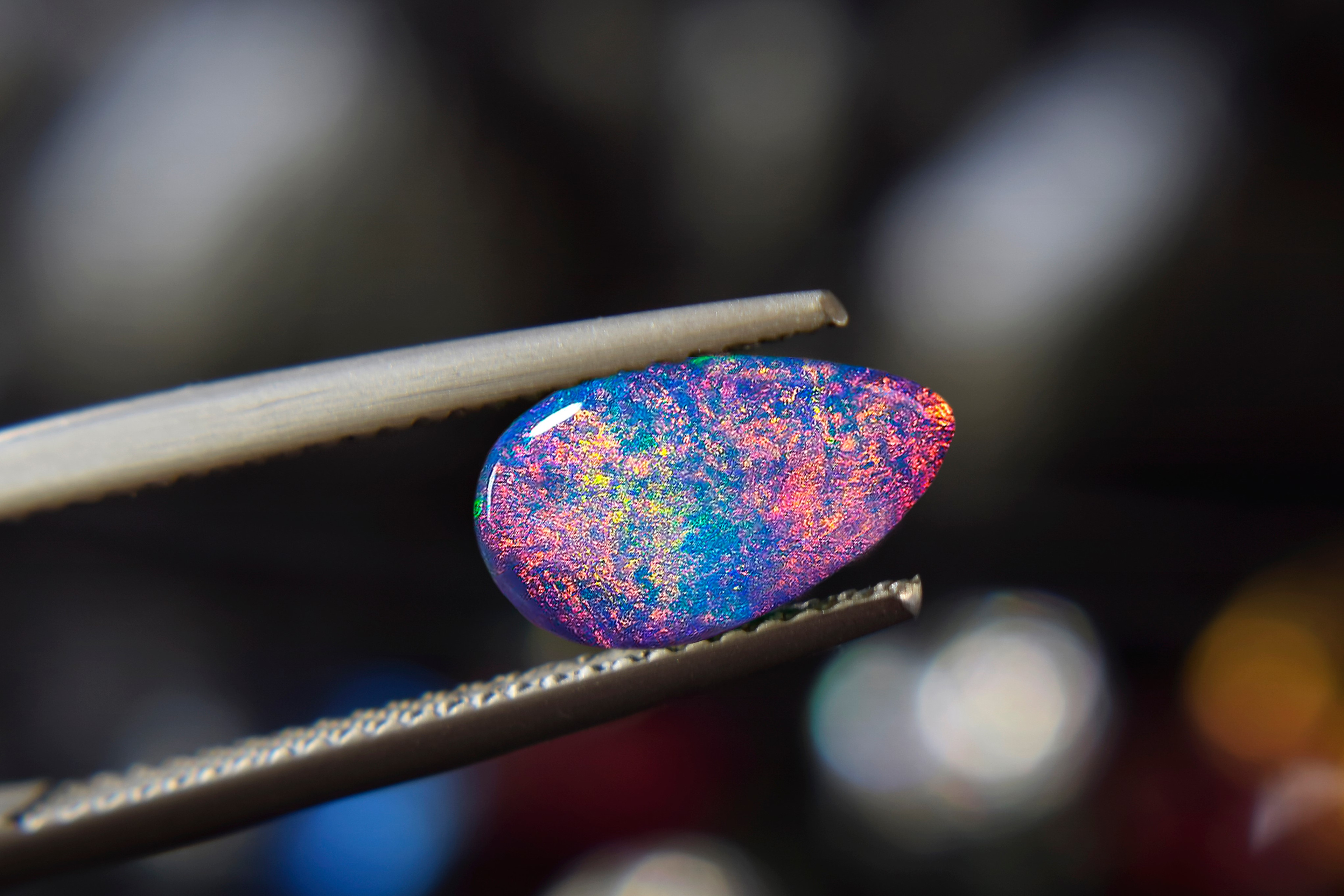From orange pumpkins to yellow leaves and black cats, October can be a very colorful month. But October is also colorful for another reason: its birthstones. If your special someone has an upcoming birthday, literally give them the rainbow with the gift of opal or tourmaline! Learn more about these vibrant stones below.
OPAL
What is an Opal?
An opal is a precious stone known for flashing a range of colors when viewed from different angles, a concept often called “play-of-color.” Opals are essentially made from dried silica (a chemical compound of silicon and oxygen). After heavy, seasonal rain soaked the ground in traditionally dry areas, the water pulled dissolved silica further underground. Once most of the rainwater evaporated, circular silica deposits were left between the layers of rock, and these later turned into opals.
Gems that feature “play-of-color” are referred to as “precious opals,” while non-flashy stones are simply called “common opals.” These beams of color appear when the tiny spheres of silica, arranged like a box of layered Ping-Pong balls, break up white light that hits the stone. Some precious opals display only one or two colors, but the rarest and most valuable gems glow with a rainbow of colors, regardless of the viewing angle.
Opals are further categorized based on their background color (aka bodycolor). Keep an eye out for these types:
- White/Light Opal: A nearly clear stone featuring play-of-color against a white or light gray background color. White/light opals are fairly common.
- Black Opal: A stone featuring a dark background color, which makes play-of-color really stand out. As a result, black opals are popular but less available than white/light opals.
- Crystal and Water Opal: Crystal opal refers to exceptional play-of-color against a relatively clear stone. On the other hand, water opal features very little play-of-color.
- Boulder Opal: This stone’s background color ranges from clear to opaque and features play-of-color. But this opal is unique, as the finished gem is cut to incorporate thin layers of opal and the rock (aka matrix) that surrounds it.
- Fire Opal: This transparent gem typically has a yellow, orange or red background color. Since red and orange are usually noticeable hues in play-of-color, you don’t always see play-of-color in fire opals. These stones are also called “Mexican opal” or “Mexican fire opal.”
*Pro Tip: When shopping for opal jewelry, the Gemological Institute of America recommends checking the stone for dead spots (aka areas where you don’t see any play-of-color). These dead spots not only make the piece less visually appealing, but they also lower the stone’s value.
History of Opal
The term “opal” appropriately gets its name from a Greek word that means “to see a change in color.” Since the 1890s, Australia has been a primary source of the world’s opal supply. These gemstones have also been mined in Ethiopia, Mexico, Brazil, Peru, Turkey and the U.S., particularly Nevada and Idaho. Scientists even developed a way to create lab-grown opal in 1974.
But these stones have actually existed for hundreds of years, representing hope, purity and truth for many European citizens. In ancient Greece, residents once thought opals protected against disease and gave owners the ability to predict the future. Ancient Arab tribes believed the gems were brought to Earth through flashes of lightning, while Romans believed their rainbow of colors made them the most precious and powerful stones.
Fun Opal Facts
- Opals are the official stones for celebrating a 14th wedding anniversary!
- Similar to snowflakes and fingerprints, you won’t find two identical opals!
- Since opals aren’t very dense, you can comfortably wear larger stones.
- Opals range between 5 and 6.5 on the Mohs Hardness Scale, a scale that ranks the durability of diamonds, gemstones and other minerals. Therefore, they aren’t as durable as other gems, such as diamonds, sapphires and rubies. Opals also contain a large amount of water and have been known to crack in extreme temperatures and under direct lighting. The American Gem Society recommends keeping your stones in a safe place, where they’re away from high temperatures or low humidity. To make them last even longer, keep them in a padded cloth bag to prevent scratching from other jewelry.
- Opals were once considered extremely lucky gems, due to their ability to showcase a range of colors. But in the 1800s, Sir Walter Scott’s novel, “Anne of Geierstein,” changed that perception. In the story, a woman collapsed and turned to ash after drops of holy water touched her opal hair clip. Since then, some believe it’s unlucky for those born in other months to wear the October birthstone.
- According to legend, some people once thought that opals could maintain the life and color of blond hair.
- You can also find opals in fossils! At times, silica has trickled into spaces surrounding wood, seashells and skeletons, creating different types of fossils.
- The play-of-color that you see in an opal is a result of the stone’s circular silica deposits. For example, silica spheres with a diameter of 0.1 micron (one ten-millionth of a meter) cast a violet hue, while a diameter of 0.2 microns give off a red shade.
- The largest and most valuable opal was seen during the 1956 Olympic Games in Melbourne, Australia. At 11 inches in length, this gem reportedly weighs 17,000 carats (equivalent to 7.6 pounds) and was valued at $2.5 million in 2005!
- Some of the world’s largest opals can be found in South Australia. In fact, it’s home to the Fire of Australia, an uncut opal weighing nearly 5,000 carats!
Shop Our Favorite Opal Jewelry
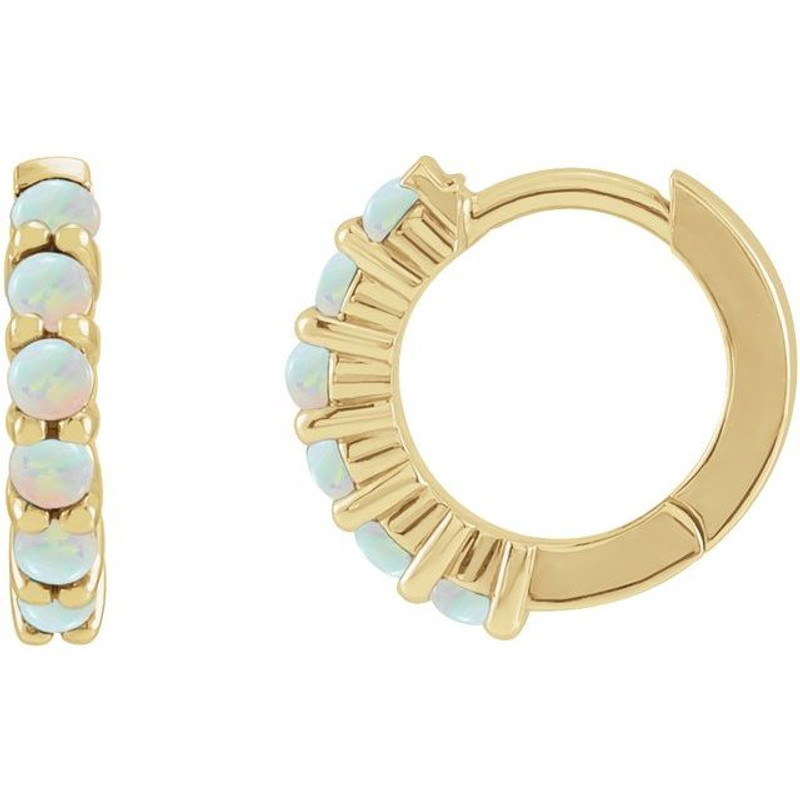
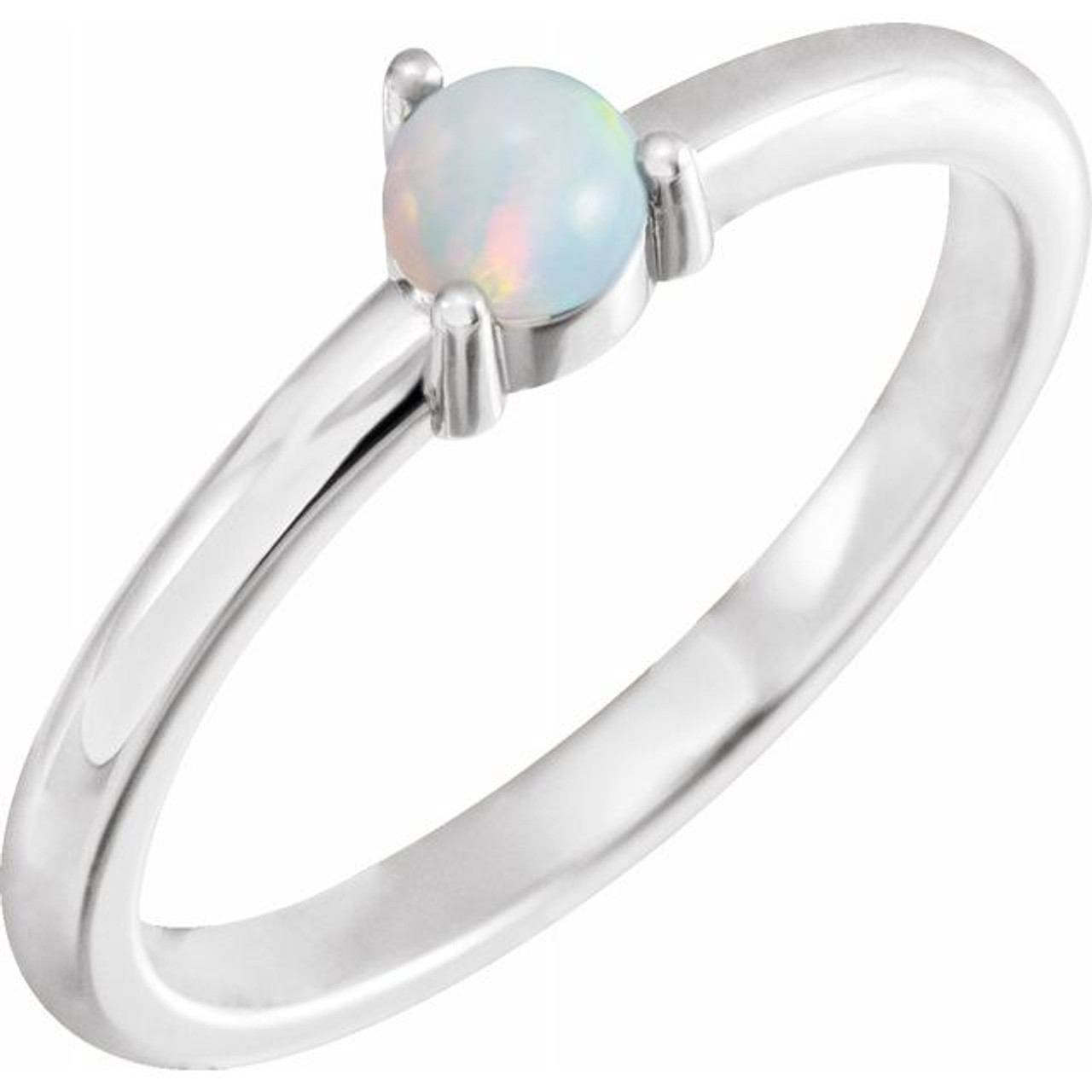
TOURMALINE
What is Tourmaline?
Tourmaline is considered the modern October birthstone, and it features one of the widest color ranges of any gem. As a result, it has often been mistaken for other stones throughout time. Unlike most gems, tourmaline isn’t composed of just one mineral. It’s instead produced by a complex group of minerals with different chemical compositions.
Some of the most popular shades include pink, red, green, blue and violet. Hints of iron and possibly titanium could be responsible for tourmaline’s green and blue colors, while manganese contributes to the gem’s red and pink shades. Some pink and yellow tourmaline could reportedly be a result of natural or laboratory-induced radiation.
Different shades of tourmaline have taken on their own names in the jewelry industry. Learn more about each of them.
- Rubellite: Refers to pink and red tourmaline with purple, orange and brown tones.
- Indicolite: Refers to dark violet-blue, traditional blue and green-blue versions of the stone.
- Paraíba: This type of blue tourmaline, ranging from violet-blue to green-blue, originated in Paraíba, Brazil.
- Chrome: Refers to an intense green shade of tourmaline. Vanadium, the same chemical element that contributes to the rich color of many Brazilian and African emeralds, is also responsible for this green tone.
- Parti-colored: As the name suggests, this type of tourmaline showcases multiple colors.
- Watermelon: Just like a watermelon, this version of the stone features a pink center surrounded by green tourmaline. These gems are even cut in slices to highlight the color arrangement. The only thing missing is the black seeds!
History of Tourmaline
Tourmaline was first discovered by Spanish conqueror Francisco Spinoza in Brazil during the 1500s, and it was actually mistaken for emeralds for multiple centuries. In fact, the term “tourmaline” comes from a Sinhalese (a language of Sri Lanka) word that means “mixed gems.” By the late 1800s, tourmaline was discovered in California and became recognized as an American gem through the work of Tiffany gemologist George F. Kunz. But around that time, the stone’s biggest market was in China. The Chinese Dowager Empress Tz’u Hsi was fond of pink and red tourmaline, so gems mined in San Diego County were sent overseas and set in jewelry.
However, the U.S. tourmaline business practically came to a halt when the Chinese government collapsed in 1912. California’s Himalaya mine was no longer generating large volumes of stones. Interest in tourmaline began to rebound over the next few decades, when large deposits were discovered in Brazil. The gem has since been found in Sri Lanka, Afghanistan, Madagascar and Kenya, among other countries.
Fun Tourmaline Facts
- Tourmaline is the official stone for celebrating an eighth wedding anniversary!
- Tourmaline scores between 7 and 7.5 on the Mohs Hardness Scale, meaning it’s a fairly durable gem and appropriate for daily wear. While it can tolerate light and most chemicals, too much heat can cause damage. Take good care of your tourmaline piece!
- Each tourmaline color symbolizes different qualities. Pink stones represent love, compassion and gentleness, while green stones represent courage, strength and stamina. If you’re eyeing black tourmaline, this shade provides the owner with protection and self-confidence.
- The Chinese Dowager Empress Tz’u Hsi was so enamored with rubellite (pink and red tourmaline) that the U.S. sent 120 tons of the gem to China between 1902 and 1910!
- Caesar’s Ruby, a 255-carat gemstone, has been considered a crown jewel of several European countries since the late 16th century. But a mineralogist later determined that the “ruby” was actually red tourmaline.
- In certain pieces of tourmaline, you can see a cat’s-eye effect (aka chatoyancy). When bright light hits the stone’s round surface, it’s reflected in a thin, perpendicular line. This effect is most often seen in green, blue or pink tourmaline, and it’s caused by multiple tube-like imperfections inside of the gem.
- Liddicoatite — a separate tourmaline species that’s rich in calcium, lithium and aluminum — was discovered in the late 1970s. The stone gets its name from former Gemological Institute of America president, Richard T. Liddicoat, who is known as the “father of modern gemology.”
- When exposed to heat and pressure, this gem has the ability to become electrically charged! Once charged, tourmaline acts like a magnet. It’s able to move back and forth as well as attract and repel dust particles.
Shop Our Favorite Tourmaline Jewelry
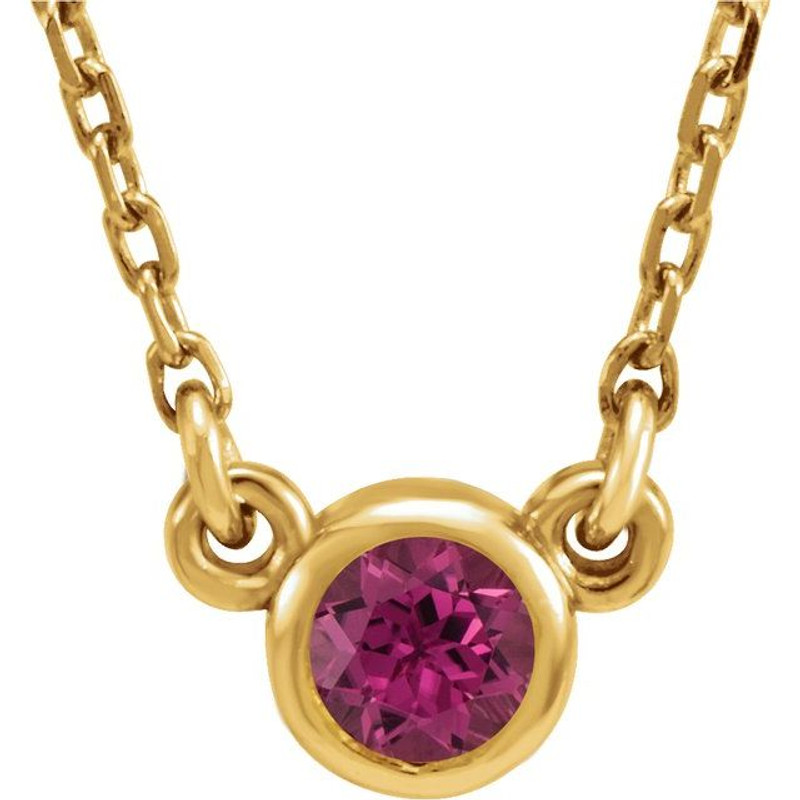
Sienna Bezel Tourmaline Necklace
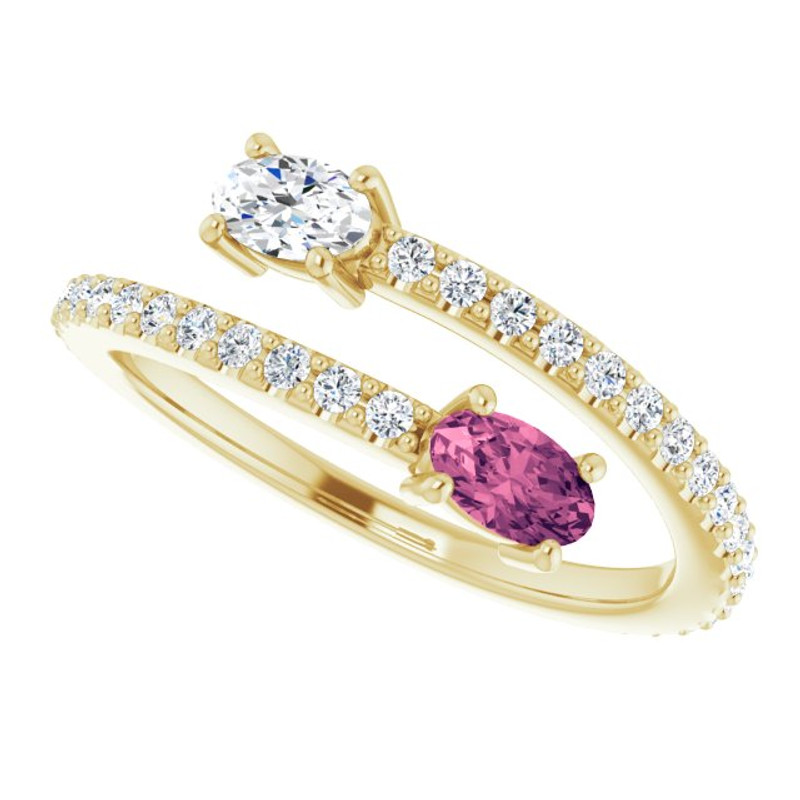
Megan Two-Tone Tourmaline Bypass Ring
Have a question? We can help!
Gage Diamonds is Chicago's premier jewelry showroom and online retailer of engagement rings, wedding bands, and fine jewelry. We offer a selection of dazzling October jewelry.
We’re committed to helping you find the ring of your dreams. For inspiration, browse our website or set up an appointment with a member of our trusted staff at our in-person showroom.
We offer no-credit-needed financing – apply and get your approval within 24 hours!
Pay over time, because love shouldn’t wait.
